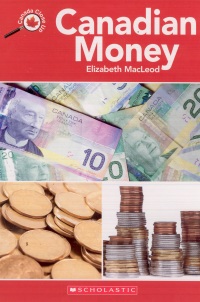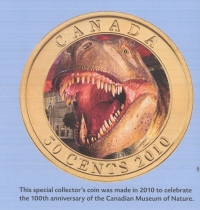| ________________
CM . . .
. Volume XVII Number 32. . . .April 22, 2011
excerpt:
Canadian Money is an excellent introduction to this country's paper and metal currency, and the book's six short chapters, ranging in length from six to 12 pages, will both inform readers and whet their appetites to acquire more detailed information about the money that daily passes through our hands. And some readers might become so interested in Canada's money that they will become numismatists. MacLeod approaches her topic in a very logical fashion and begins with "The Story of Money" which traces how coinage replaced the actual objects of bartering and other means of payment for goods and services. The latter part of this chapter focuses on the history of coins and other forms of currency that were once utilized in Canada. "Bills and Bank Notes" principally deals with how Canada's "paper" money is actually manufactured while "Canada's Coins" does the same for the nation's coins. Chapter 4, "Collecting Coins," offers a brief introduction to the hobby of coin collecting and stresses circulating coins as opposed to the special collector coins that are created just for collectors and which are not expected to be "pocket change." Chapter 5 "Using Money" somewhat strays off topic as its five text pages deal with some of the alternatives to actually carrying around bills and coins - bank machines, credit and debit cards, cheques - and introduces the concept of interest. The book's final chapter, "What's Ahead for Canada's Money?", considers how Canadian coins might change - the disappearance of the penny and the possible introduction of a $5.00 coin. Using a $20.00 bill as an example, this chapter also provides an excellent explanation of the special features Canada has incorporated into its bills in an attempt to foil counterfeiters
Words that have been bolded in the text are defined in the two-page closing "Glossary" that is followed by a one-page "Index." Highly Recommended. Dave Jenkinson, CM's editor, lives in Winnipeg, MB, the home of the Canadian Mint that produces Canada's coins.
To comment
on this title or this review, send mail to cm@umanitoba.ca.
Copyright © the Manitoba Library Association. Reproduction for personal
use is permitted only if this copyright notice is maintained. Any
other reproduction is prohibited without permission.
NEXT REVIEW |
TABLE OF CONTENTS FOR THIS ISSUE
- April 22, 2011.
AUTHORS |
TITLES |
MEDIA REVIEWS |
PROFILES |
BACK ISSUES |
SEARCH |
CMARCHIVE |
HOME |

 The colour photographs of money are more than decorative and often add information that is not found in the main text. For example, the above excerpt states that Canada once had a thousand dollar bill, but that same page bears a photo of a $50,000 bill that was in existence during the reign of King George V.
The colour photographs of money are more than decorative and often add information that is not found in the main text. For example, the above excerpt states that Canada once had a thousand dollar bill, but that same page bears a photo of a $50,000 bill that was in existence during the reign of King George V.